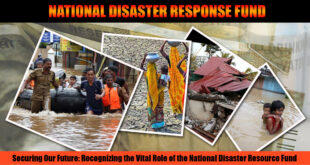TOPICS COVERED: Salient features of world’s physical geography
Context:
Following heavy rains in Himachal Pradesh, landslides have occurred in the state.
About a cloudburst
- A cloudburst is a localised but intense rainfall activity.
- While it can also occur in plains, the phenomenon is most common in hilly regions.
- Not all instances of very heavy rainfall, however, are cloudbursts.
- A cloudburst has a very specific definition:
- Rainfall of 10 cm or more in an hour over a roughly 10 km x 10 km area is classified as a cloudburst event.
- By this definition, 5 cm of rainfall in a half-hour period over the same area would also be categorised as a cloudburst.
Average rainfall in India:
- In a normal year, India, as a whole, receives about 116 cm of rainfall over the entire year.
- This means if the entire rainfall everywhere in India during a year was spread evenly over its area, the total accumulated water would be 116 cm high.
- There are huge geographical variations in rainfall within the country, and some areas receive over 10 times more than that amount in a year.
- But on average, any place in India can be expected to receive about 116 cm of rain in a year.
Cloudburst vs average rainfall:
During a cloudburst event, a place receives about 10% of this annual rainfall within an hour.
How common are cloudbursts?
- Cloudbursts are not uncommon events, particularly during the monsoon months.
- Most of these happen in the Himalayan states where the local topology, wind systems, and temperature gradients between the lower and upper atmosphere facilitate the occurrence of such events.
- These events are highly localized.
- They take place in very small areas which are often devoid of rainfall-measuring instruments.
- The consequences of these events, however, are not confined to small areas.
- Because of the nature of the terrain, the heavy rainfall events often trigger landslides and flash floods, causing extensive destruction downstream.
- This is the reason why every sudden downpour that leads to the destruction of life and property in the hilly areas gets described as a “cloudburst”, irrespective of whether the amount of rainfall meets the defining criteria.
Can cloudbursts be forecast?
- The Indian Metrological Department forecasts rainfall events well in advance, but it does not predict the quantum of rainfall.
- The forecasts can be about light, heavy, or very heavy rainfall, but weather scientists do not have the capability to predict exactly how much rain is likely to fall at any given place.
- The forecasts are for a relatively large geographical area, at best at a district level.
- As they zoom in over smaller areas, the forecasts get more and more uncertain.
- Specific cloudburst events cannot be forecast.
SOURCE: THE HINDU, THE ECONOMIC TIMES, PIB
 Chinmaya IAS Academy – Current Affairs Chinmaya IAS Academy – Current Affairs
Chinmaya IAS Academy – Current Affairs Chinmaya IAS Academy – Current Affairs



